
|

|
Viking Age Arms and Armor
Other Defenses
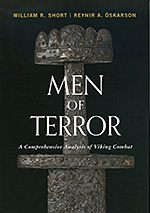 |
Much of the text presented on this page is out-of-date. Until we find time to make the needed updates to this page, we strongly encourage readers to look at this topic as it is presented in our new book, Men of Terror, available now from your favorite book seller. |
|
The sagas mention other personal defenses. In chapter 45 of Eyrbyggja saga, Freysteinn was protected from a sword cut to his neck by a piece of horn sewn into his felt hat. In chapter 41 of Vatnsdęla saga, Ingólfur put flat stones on his chest and back, which protected him when he attacked a band of thieves. |
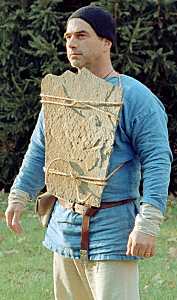 |
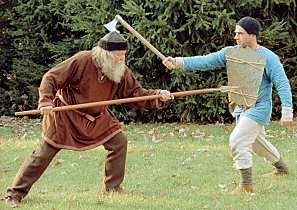 |
In chapter 2 of Vopnfiršinga saga, Brodd-Helgi similarly protected himself with flat stones under his clothing. When Svartr thrust at Brodd-Helgi with his halberd (höggspjót), it glanced off the stone so violently that Svartr pitched forward, allowing Brodd-Helgi to cut off his leg. The event took place on Smjörvatnsheiši below Smjörfjöll in Iceland, shown to the right as it appears today. |
 |
Occasionally, objects worn on the body provided protection from an attack, even though they were never intended to serve as armor. In chapter 58 of Eyrbyggja saga, Óspakr and Žórir were fighting. Žórir lunged at Óspakr with his knife, but Óspakr avoided the attack. Žórir overcommitted and fell forward on his knees, with his head down. Óspakr drove his axe into Žórir's back. However, Žórir had a knife hanging from a strap around his neck. The knife had slipped around to his back, and it took the force of the blow. Žórir received only a slight wound on either side of the knife.
|
In chapter 44 of Eyrbyggja saga, Snorri goši and his men fought against Steinžórr and his men at Geirvör in Įlftafjöršur (shown to the right as it appears today). Snorri requested a truce from Steinžór's people, and Steinžórr replied by asking Snorri to extend a hand, presumably to seal the truce. However, Steinžórr treacherously cut at Snorri's outstretched arm with his sword. The sword landed on Snorri's temple ring (which was probably worn on the upper arm). Snorri was unhurt, but the ring was nearly broken in two. |
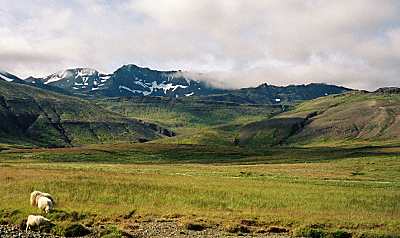 |
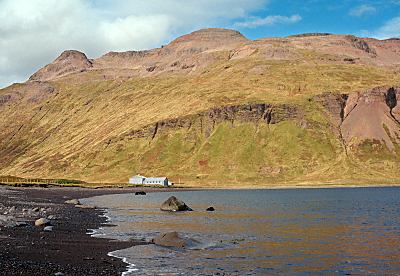 |
In chapter 11 of Grettis saga, Žorgeir walked to the boat shed at Reykjarfjöršur (left, as the farm appears today) before dawn to prepare for a day of fishing. Žorfinnr came up behind him and drove his axe into Žorgeir's back so that it sank in between his shoulder blades. Žorfinnr released the axe and ran away. What Žorfinnr didn't see was that Žorgeir had a leather flask full of drink on his back, which took the full force of the axe blow. The flask was ruined, but Žorgeir was unharmed. Žorgeir's flask might have resembled the reproduction leather flask shown to the right. |
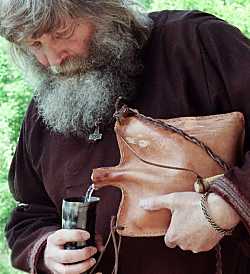 |
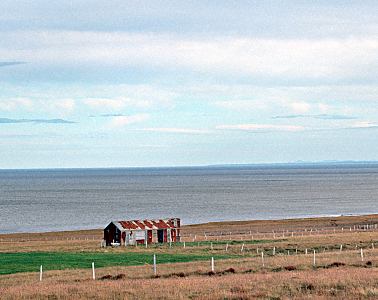 |
Some believe that Žorgeir's farm was at Reykjanes, where the fjord opens to the sea (left). Either could be supported by the saga text. The stories describe ways in which fights were stopped by third parties. The most common method was to throw clothing or blankets onto the combatants' weapons, rendering them ineffectual. This was done by men to capture an opponent without harming him (Egils saga chapter 46) or by women to stop a fight as happened in the fight at Eyvindarstašir (right) described in chapter 18 of Vopnfiršinga saga. |
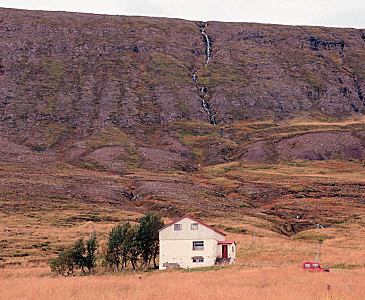 |
One clever trick is described in chapter 15 of Gull-Žóris saga. Žórir and Steinólfur were fighting, and men joined the battle on both sides. But some of Steinólf's men saw a large group of men riding towards the battle from a farm that would be supporting Žórir. Steinólf's men, fearing overwhelming numbers were about to join the battle, turned and headed for their ships. Only later was it revealed that the large group of approaching "men" were cattle being driven towards the battle site with clothing draped over their horns.
|
|
In another case, it was done by an unarmed man while under attack. In chapter 39 of Finnboga saga ramma, Žorgrķmur grabbed a hidden sword and attacked Finnbogi, who was unarmed. Finnbogi threw his cloak over the sword to reduce its effectiveness, and then grappled with Žorgrķmur, bringing him down and killing him. One might think it would be easy for a swordsman to continue fighting with a cloak on his sword, or at least to throw it off. The cloak, weighing nearly as much (if not more than) the sword significantly unbalances it, making control of the sword difficult. Additionally, if the cloak is thrown with a twist (like throwing out a fishing net) it entangles itself around the swordsman's arm and weapon (and head), making removal difficult and possibly resulting in a disarm. A speculative reconstruction of a disarm with a cloak is shown in this combat demo video, part of a longer fight. The video linked on the left shows how a cloak can be thrown from the side to entangle a swordsman. The photo on the right shows a round of sparring in which a cloak is used to defend against two swords in a Hurstwic Viking combat training session. |
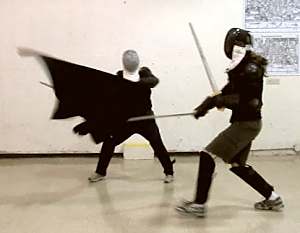 |
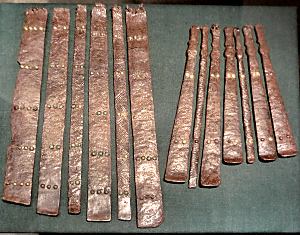 |
Some believe that Viking fighters used splinted armor, armor made from metal strips attached to leather straps fastened around legs and arms to prevent edged weapons from biting. Remains of this type of armor are found from the Viking age outside of Viking lands, and in some Viking trading centers. Additionally, the armor is found in Scandinavia, but from before the Viking era, such as the 7th century metal splints found at Valsgärde in Sweden shown to the left. I do not find the evidence convincing for the use of this kind of armor in Viking lands. |
|
|
<< Previous article |
Back to Arms and Armor |
Next article >> |
|
©1999-2026 William R. Short |